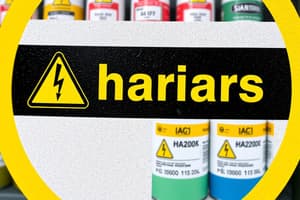Podcast
Questions and Answers
Which type of chemical hazard includes substances like carbon monoxide and cyanide?
Which type of chemical hazard includes substances like carbon monoxide and cyanide?
- Asphyxiants (correct)
- Corrosives
- Irritants
- Flammable
What is the main focus of the RAMP concept in handling chemical hazards?
What is the main focus of the RAMP concept in handling chemical hazards?
- Minimize the risks of the hazards (correct)
- Assess the risks of the hazards
- Prepare for emergencies from uncontrolled hazards
- Recognize the hazards
Which combination of substances can produce violent and explosive reactions, according to the text?
Which combination of substances can produce violent and explosive reactions, according to the text?
- Methanol with Sulfuric acid
- Benzene with Sodium hydroxide
- Acetone with Hydrogen peroxide (correct)
- Ethyl acetate with Sodium carbonate
Diethyl ether is mainly known for being:
Diethyl ether is mainly known for being:
What term is often used interchangeably with 'hazard' according to the text?
What term is often used interchangeably with 'hazard' according to the text?
What has been a source of explosions due to inappropriate or inadvertent mixing according to the text?
What has been a source of explosions due to inappropriate or inadvertent mixing according to the text?
What should you do if a solid chemical spills on your skin?
What should you do if a solid chemical spills on your skin?
Which Chemical Safety Level (CSL) involves work with explosives or potentially explosive compounds?
Which Chemical Safety Level (CSL) involves work with explosives or potentially explosive compounds?
What should you do if skin or clothing is contaminated with larger spills of a liquid chemical?
What should you do if skin or clothing is contaminated with larger spills of a liquid chemical?
What is the appropriate attire for working in a lab according to the text?
What is the appropriate attire for working in a lab according to the text?
What should be used in case of a fire?
What should be used in case of a fire?
What is the maximum amount of flammable liquids allowed for CSL Level 1?
What is the maximum amount of flammable liquids allowed for CSL Level 1?
Which level of CSL has minimal health or physical hazard from chemicals?
Which level of CSL has minimal health or physical hazard from chemicals?
What is important to do before using any chemical in the lab?
What is important to do before using any chemical in the lab?
What should you do if a small liquid spill or splash affects only a small area of skin?
What should you do if a small liquid spill or splash affects only a small area of skin?
What should you wear for safety in the lab according to the text?
What should you wear for safety in the lab according to the text?
Flashcards are hidden until you start studying




